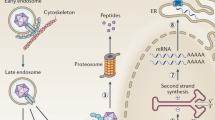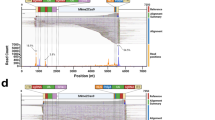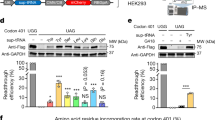Abstract
Therapeutic gene delivery typically involves the addition of a transgene expression cassette to mutant cells. This approach is complicated by transgene silencing, aberrant transcriptional regulation and insertional mutagenesis. An alternative strategy is to correct mutations through homologous recombination, allowing for normal regulation of gene expression from the endogenous locus. Adeno-associated virus (AAV) vectors containing single-stranded DNA efficiently transduce cells in vivo and have been shown to target homologous chromosomal sequences in cultured cells1. To determine whether AAV-mediated gene targeting can occur in vivo, we developed a mouse model that contains a mutant, nuclear-localized lacZ gene inserted at the ubiquitously expressed ROSA26 locus. Foci of β-galactosidase-positive hepatocytes were observed in these mice after injection with an AAV vector containing a lacZ gene fragment, and precise correction of the 4-bp deletion was demonstrated by gene sequencing. We also used AAV gene-targeting vectors to correct the naturally occurring GusB gene mutation responsible for murine mucopolysaccharidosis type VII2.
This is a preview of subscription content, access via your institution
Access options
Subscribe to this journal
Receive 12 print issues and online access
$209.00 per year
only $17.42 per issue
Buy this article
- Purchase on Springer Link
- Instant access to full article PDF
Prices may be subject to local taxes which are calculated during checkout



Similar content being viewed by others
References
Russell, D.W. & Hirata, R.K. Human gene targeting by viral vectors. Nat. Genet. 18, 325–330 (1998).
Sands, M.S. & Birkenmeier, E.H. A single-base-pair deletion in the beta-glucuronidase gene accounts for the phenotype of murine mucopolysaccharidosis type VII. Proc. Natl. Acad. Sci. USA 90, 6567–6571 (1993).
Miller, D.G., Petek, L.M. & Russell, D.W. Human gene targeting by adeno-associated virus vectors is enhanced by DNA double-strand breaks. Mol. Cell. Biol. 23, 3550–3557 (2003).
Soriano, P. Generalized lacZ expression with the ROSA26 Cre reporter strain. Nat. Genet. 21, 70–71 (1999).
Liu, X. et al. Targeted correction of single-base-pair mutations with adeno-associated virus vectors under nonselective conditions. J. Virol. 78, 4165–4175 (2004).
Koeberl, D.D., Alexander, I.E., Halbert, C.L., Russell, D.W. & Miller, A.D. Persistent expression of human clotting factor IX from mouse liver after intravenous injection of adeno-associated virus vectors. Proc. Natl. Acad. Sci. USA 94, 1426–1431 (1997).
Trobridge, G., Hirata, R.K. & Russell, D.W. Gene targeting by adeno-associated virus vectors is cell-cycle dependent. Hum. Gene Ther. 16, 522–526 (2005).
Gossen, J.A., de Leeuw, W.J., Molijn, A.C. & Vijg, J. Plasmid rescue from transgenic mouse DNA using LacI repressor protein conjugated to magnetic beads. Biotechniques 14, 624–629 (1993).
Birkenmeier, E.H. et al. Murine mucopolysaccharidosis type VII. Characterization of a mouse with beta-glucuronidase deficiency. J. Clin. Invest. 83, 1258–1266 (1989).
Gillett, P.M. et al. Mucopolysaccharidosis type VII (Sly syndrome) presenting as neonatal cholestasis with hepatosplenomegaly. J. Pediatr. Gastroenterol. Nutr. 33, 216–220 (2001).
Wolfe, J.H. et al. High level expression and export of beta-glucuronidase from murine mucopolysaccharidosis VII cells corrected by a double-copy retrovirus vector. Gene Ther. 2, 70–78 (1995).
Wolfe, J.H. et al. Reversal of pathology in murine mucopolysaccharidosis type VII by somatic cell gene transfer. Nature 360, 749–753 (1992).
Grimm, D. et al. Preclinical in vivo evaluation of pseudotyped adeno-associated virus vectors for liver gene therapy. Blood 102, 2412–2419 (2003).
Vijg, J., Dolle, M.E., Martus, H.J. & Boerrigter, M.E. Transgenic mouse models for studying mutations in vivo: applications in aging research. Mech. Ageing Dev. 99, 257–271 (1997).
Nickerson, H.D. & Colledge, W.H.A. LacZ-based transgenic mouse for detection of somatic gene repair events in vivo. Gene Ther. 11, 1351–1357 (2004).
Vasquez, K.M., Narayanan, L. & Glazer, P.M. Specific mutations induced by triplex-forming oligonucleotides in mice. Science 290, 530–533 (2000).
Kren, B.T. et al. Correction of the UDP-glucuronosyltransferase gene defect in the gunn rat model of crigler-najjar syndrome type I with a chimeric oligonucleotide. Proc. Natl. Acad. Sci. USA 96, 10349–10354 (1999).
Albuquerque-Silva, J., Vassart, G., Lavinha, J. & Abramowicz, M.J. Chimeraplasty validation. Nat. Biotechnol. 19, 1011 (2001).
van der Steege, G. et al. Persistent failures in gene repair. Nat. Biotechnol. 19, 305–306 (2001).
Graham, I.R. et al. Gene repair validation. Nat. Biotechnol. 19, 507–508 (2001).
Hendrie, P.C. & Russell, D.W. Gene targeting with viral vectors. Mol. Ther. 12, 9–17 (2005).
Hirata, R., Chamberlain, J., Dong, R. & Russell, D.W. Targeted transgene insertion into human chromosomes by adeno-associated virus vectors. Nat. Biotechnol. 20, 735–738 (2002).
Inoue, N., Hirata, R.K. & Russell, D.W. High-fidelity correction of mutations at multiple chromosomal positions by adeno-associated virus vectors. J. Virol. 73, 7376–7380 (1999).
Ware, C.B., Siverts, L.A., Nelson, A.M., Morton, J.F. & Ladiges, W.C. Utility of a C57BL/6 ES line versus 129 ES lines for targeted mutations in mice. Transgenic Res. 12, 743–746 (2003).
Sands, M.S. & Barker, J.E. Percutaneous intravenous injection in neonatal mice. Lab. Anim. Sci. 49, 328–330 (1999).
Grimm, D., Kern, A., Rittner, K. & Kleinschmidt, J.A. Novel tools for production and purification of recombinant adenoassociated virus vectors. Hum. Gene Ther. 9, 2745–2760 (1998).
Gregorevic, P. et al. Systemic delivery of genes to striated muscles using adeno-associated viral vectors. Nat. Med. 10, 828–834 (2004).
Zolotukhin, S. et al. Recombinant adeno-associated virus purification using novel methods improves infectious titer and yield. Gene Ther. 6, 973–985 (1999).
Gossen, J.A. & Vijg, J. E. coli C: a convenient host strain for rescue of highly methylated DNA. Nucleic Acids Res. 16, 9343 (1988).
Sands, M.S. et al. Treatment of murine mucopolysaccharidosis type VII by syngeneic bone marrow transplantation in neonates. Lab. Invest. 68, 676–686 (1993).
Acknowledgements
We thank Rong Dong and Marie Roberts for expert technical assistance, Richard Newton for plasmid DNA purification, and Carol Ware, La'Akea Siverts and the Transgenic Core Facility at the University of Washington for help with transgenic mice. These studies were funded by grants from the US National Institutes of Health.
Author information
Authors and Affiliations
Corresponding author
Ethics declarations
Competing interests
The authors declare no competing financial interests.
Supplementary information
Supplementary Fig. 1
Enrichment of target loci from genomic DNA. (PDF 331 kb)
Supplementary Table 1
Time dependence of GusB gene targeting frequencies. (PDF 51 kb)
Rights and permissions
About this article
Cite this article
Miller, D., Wang, PR., Petek, L. et al. Gene targeting in vivo by adeno-associated virus vectors. Nat Biotechnol 24, 1022–1026 (2006). https://doi.org/10.1038/nbt1231
Received:
Accepted:
Published:
Issue Date:
DOI: https://doi.org/10.1038/nbt1231
This article is cited by
-
Identification of liver-specific enhancer–promoter activity in the 3′ untranslated region of the wild-type AAV2 genome
Nature Genetics (2017)
-
Engineered Viruses as Genome Editing Devices
Molecular Therapy (2016)
-
CRISPR/Cas9-AAV Mediated Knock-in at NRL Locus in Human Embryonic Stem Cells
Molecular Therapy - Nucleic Acids (2016)
-
Genome-editing Technologies for Gene and Cell Therapy
Molecular Therapy (2016)
-
Therapeutic genome editing: prospects and challenges
Nature Medicine (2015)



